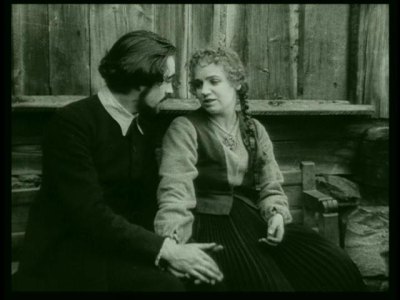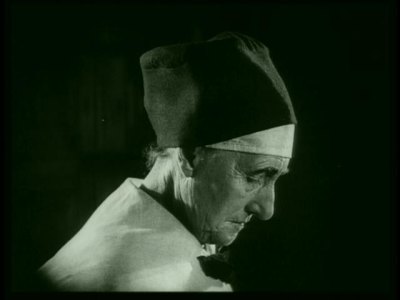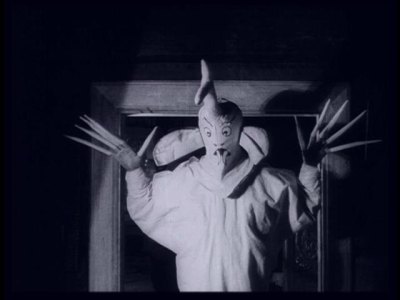| Reviews & Columns |
|
Reviews DVD TV on DVD Blu-ray 4K UHD International DVDs In Theaters Reviews by Studio Video Games Features Collector Series DVDs Easter Egg Database Interviews DVD Talk Radio Feature Articles Columns Anime Talk DVD Savant Horror DVDs The M.O.D. Squad Art House HD Talk Silent DVD
|
DVD Talk Forum |
|
|
| Resources |
|
DVD Price Search Customer Service #'s RCE Info Links |
|
Columns
|
|
|
Parson's Widow, The
Carl Theodor Dreyer was one of the masters of early cinema. He created films that both painted beautiful images on the screen and containing powerful emotions. His most famous film, The Passion of Joan of Arc, is just as gorgeous to watch as it is moving. One of his lesser known films, but still an excellent work, is 1920's The Parson's Widow. This was only the third film that Dreyer directed, and while his technique and narrative form would evolve and grow in future films, the seeds of his greatness are clearly evident in this wonderful light comedy.

Set in the seventeenth century, young Sofren has returned home to his love Mari after several years away at seminary school. She has waited faithfully for him, but her father won't allow her to marry Sofren until he is earning a living and has a position as a parson.
Fortunately for Sofren, an opening comes up in a nearby village when their parson passes away. The eager young man beats out two other candidates for the position and thinks he has it made; until he finds out about the catch. The local tradition has it that the previous parson's wife can ask for the hand of the person taking on the new job. The parson's widow, Dame Margarete, is a very old and stern woman and she does indeed want to marry Sofren. This marriage will prevent her from being kicked out of the parson's house, and ensure that she is still supported. Crestfallen at this turn of events, Sofren walks the widow home. Though he has no intention of marring her, to be courteous he accepts her invitation to dine with her. She sets out an amazing array of good food, and plenty of schnaps. Sofren has a little too much to drink, and while he's tipsy he imagines Dame Margarete as she must have appeared when she was a young girl herself. Smitten by the image, he proposes to her.

Mari is understandably upset at this turn of events. She'd like Sofren to decline the position, but then they couldn't get married. They decide to introduce Mari as Sofren's sister, and after Dame Margarete's and Sofren's marriage, she moves in with the couple. (Who are married in name only of course.) The rest of the film is taken up with Sofren's attempts to catch a few moments alone with Mari, and how he gets frustrated at every turn.
I was a little worried about how Dreyer would handle a comedy. His other movies have very little humorous content at all, and I wasn't sure if he would be able to create a light mood, but he did an admirable job. While the film isn't a laugh-fest like a Chaplin or Keaton film, there were many amusing moments and the movie did have a light tone to it. The scene where Sofren dressed up as Satan to frighten Dame Margarete was very funny, as was the time he reached through the weaving loom to take Mari's hand, only to find the servant weaving. The film also had a several comic incidents that were less broad but still entertaining, such as in the wedding ceremony when the parson tries to put the wedding ring on Dame Margarete's finger, only to find that there is no room since there are three other wedding rings already on her finger.

While this film is not the somber and dramatic Dreyer that most audiences know from The Passion of Joan of Arc and Gertrude, it still shares some of the techniques and style that he would use in his more famous works. While this film is not as carefully paced as his other works, it still contains some strong emotions that are expressed through closeups and static shots. You can feel the conflicting emotions that Sofren is experiencing when he finds out that he is expected to marry Dame Margarete, and the closeups on her blank face project a lot of meaning too. Dreyer employs a lot of irising techniques to focus on the important elements in a frame. This is evident in the closing shot where he irises into a pair of figures and surrounds them with a cross.
There are a lot of examples of symmetry and repeated patterns in this movie too. Not only do Sofren's attempts to spend time with Mari have a similar feel to them, but when Dame Margarete's background is discovered there is a feeling of history repeating itself. The ending of the movie also echo's the first scene in the film, but with almost opposite emotions. This gives the film a very poignant feeling.
This movie, like many of Dreyer's other works, deals with moral integrity and personal obligations. The major difference is that this work places them up in a comical setting. The meaning of the film is still very apparent though, and it can be argued that the films message was enhanced because of the humor. Dreyer does a skillful job weaving the amusing sections of the film in and around the more serious parts, creating a film that is light in tone, but still has the emotional impact that he's famous for.
The DVD:
Audio:
The piano track that accompanies the film was arranged by Neal Kurz from the work of Edvard Grieg, the great Norwegian composer. The choice of music, as well as the composer, was very good. Mr. Kurz was able to take music that would have been known at the time this film was released and expertly match it to the scenes of the film. Had I not known better, I would have thought that this was an original composition. Mr. Kurz performance sounded excellent to my untrained ear and added a lot to the enjoyment of the film. As a nice extra, Image included a list of the music that was used in the score and a sub-menu that will take you directly to any number. The intertitles are in English, and there are not any foreign language subtitles present.
Video:
This movie has been restored by David Shepard through his company Film Preservation Associates from 35 mm prints. Shepard has been involved with many restorations of silent films, and this film is one of his best. The image is very clear, with an excellent amount of contrast and a very good detail. The movie is tinted and has been speed corrected according to the DVD case. Like just about all silent films, this has some speckling and dirt on it, and there is the occasional missing frame or two, but this are very minor defects. This film looks just simply fabulous.
Extras:
This disc includes a couple of shorts that Dreyer directed. The first is They Caught the Ferry (De Naede Faergen) from 1948. A man and woman get off a ferry and find out that they have 45 minutes to catch the Nyborg ferry that is 70 km away. They hop on his motorcycle and speed through the Dutch countryside. The scenery is beautiful, and Dreyer's direction is interesting. He has 1st person POV shots taken from the moving motorcycle, and shots looking down on the moving front tire which really creates the illusion of speed. The ending of the film was unexpected and worked very well. A very good short.
The second short is Thorvaldsen: Denmark's Great Sculptor (1949.) This short gives a short biography of the artist and then examines many of his works. They note changes in his style and discuss the meaning and feelings in his work. After seeing this film, it is easy to understand why Dreyer picked Thorvaldsen as his subject. The sculptor's work is similar in feeling and outlook as much of Deryer's output. There are both English and Danish audio tracks, with the former having a lot more hiss than the later.
Final Thoughts:
This was a very enjoyable film. I laughed at the comic touches, but still felt the young couple's pain at not being able to be together. The way Dreyer transforms the viewer's impressions of Dame Margarete in the film is masterful. The restored video looks better than it has any right to, and Neal Kurz's piano score fits the movie well. The fact that this DVD includes two other Dreyer shorts, both of which are very good, make this a solid addition to any DVD collection. Highly Recommended.
|
| Popular Reviews |
| Sponsored Links |
|
|
| Sponsored Links |
|
|
| Release List | Reviews | Shop | Newsletter | Forum | DVD Giveaways | Blu-Ray | Advertise |
|
Copyright 2024 DVDTalk.com All Rights Reserved. Legal Info, Privacy Policy, Terms of Use,
Manage Preferences,
Your Privacy Choices | |||||||














